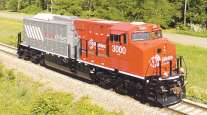Senior Reporter
Safer Solutions Sought for Hazmat Drivers Traveling Colorado’s Treacherous Loveland Pass

With its 180-degree bends, 7% grades, dangerous drop-offs and strong wind gusts, the hazardous material truck drivers hauling heavy petroleum loads who make the 9.5-mile journey though Colorado’s Loveland Pass call the drive a “white-knuckle experience.”
Were it not for the flammable loads they carry, those same truckers would not have to divert off Interstate 70. Instead, they would be able to travel though the 1.7-mile Eisenhower Tunnel that cuts through the mountains, shaving as much as 90 minutes from taking the dangerous two-lane U.S. 6 that travels over the Continental Divide.
No wonder executives with the Colorado Motor Carriers Association and Colorado Wyoming Petroleum Marketers Association have for years been pressing members of the state Legislature and Colorado Department of Transportation to use the tunnel route for the up-to-200 tankers that each day are forced to take the dangerous road.
So far, they haven’t succeeded, but another attempt for resolution began last month at a meeting in Austin, Texas, with American Trucking Associations’ hazmat policy committee.

Horvath
Dan Horvath, ATA’s director of safety policy and staff contact with the hazmat policy committee, said the committee has formed a working group and soon will speak with carriers and drivers who use the pass.
Andy Karsian, legislative liaison for the CDOT, said the reason the state does not allow hazmat trucks in the tunnel is because of concerns that a fire, accident or fuel spill would damage the structure and create a traffic mess. Then there are the environmentalists who are concerned that a spill could send toxic petroleum into the state’s pristine bodies of water.
“There’s no way in hell you would catch me up there driving one of these trucks and going over that pass,” Karsian said. “We’ve had close calls, but we’ve been lucky so far with the skills and the professionalism of the truckers going over the pass.”
By contrast, the Eisenhower Tunnel is a four-lane vehicular tunnel about 60 miles west of Denver. The tunnel carries as many as 1 million vehicles a month on I-70 in easterly and westerly directions at an elevation of more than 11,000 feet in the Rocky Mountains. On the weekends, the tunnel traffic is more like an urban than rural freeway with skiers in the winter and hikers and bikers in the summertime.
The vast majority of the petroleum trucks taking the Loveland Pass route originate in Denver and carry critical supplies of oil, gasoline and diesel to the communities, gas stations and resorts west of the tunnel, according CMCA President Greg Fulton.
He said his association has for many years been concerned that traveling through Loveland Pass presents a danger to the health, welfare and safety of the drivers.
Fulton said that during the winter, truck drivers, who are often older and unfit, have to put on 60- to 100-pound tire chains in thinner air that can cause respiratory and heart problems due to altitude sickness.
“The weather conditions can change quickly, and driving through the pass can be physically draining, causing drivers to become fatigued,” he said. “And even the best of drivers can hit ice spots that can send a truck out of control.”
CDOT’s Karsian acknowledges the arrangement is problematic for hazmat truckers but says finding a solution is difficult. To fix the tunnel with a better fire-suppression system and having first responders nearby would be expensive and difficult to pull off due to state laws that require voter approval to increase funding.
(Two state transportation referendums “failed miserably” earlier this month, Karsian said.)
Another possible solution could be to escort the trucks through the tunnel at specific times. However, that solution could cause huge traffic backups, he said.
“We need to have a larger stakeholder conversation and, as with any major problem, it always behooves getting everybody in the room and having a conversation. But anything we discuss is going to have a price tag,” Karsian said. “And that’s the largest stumbling block.”
CWPMA Executive Director Grier Bailey said that hazmat truck accidents occur about once every 18 months. He added that tank carriers could collectively save $1.3 million a year if they were allowed to pass through the tunnel with escort at the top of every hour and $2.6 million if they were allowed free passage though the tunnel.
Dean Teter, traffic manager and safety director for Denver-based Dixon Brothers, oversees the drivers who must go over the pass regularly. He drove the route for many years and found it treacherous.
“I’ve got guys that go over the pass every day,” Teter said. “It’s narrow, there’s only two lanes and a lot of shoulders where there’s just nothing. Even where there are barriers, it’s not like it’s going to keep you from driving off the edge of the mountain in a loaded truck.”




